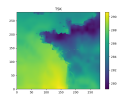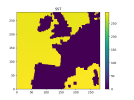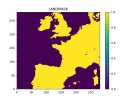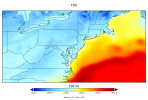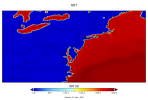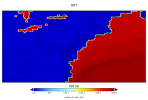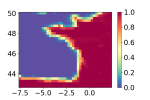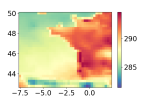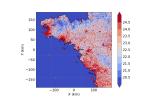I have noticed that there is an issue with the land sea mask that you get from ECMWF is not binary.

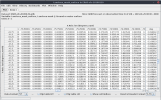
This is also noted on ECMWF webpage:
Land-sea mask in ERA5 and ERA-Interim - Copernicus User Support Forum - ECMWF Confluence Wiki
Because the mask is not binary I believe it creates an issue with metgrid log
INFORM: Field LANDSEA.mask does not have a valid mask and will not be checked for missing values
which I believe causes issues with TSLB in the wrfinput files
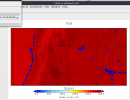
Is there a standard with dealing with these issues? Such as modifying the SFC grib file and changing the values to be either 0/1 based or modifying the TSLB or some other variable in the met_em files to be the fill_value of 285? I thought it could possiblyy be a issue with the model level data but I've done it with Pressure levels from ERA5 and TSLB also shows up as 0K along areas of water. I should note that TSLB is 0K in the wrfout 00 hour file but in other files, the 0K issue has been fixed to be a single constant value over areas of water.
I have also provided a MFT link to some of my files from my run, that I left uncompleted. Let me know if other files would be needed that you also wish to examine.
https://mft.aer.com/download?domain...b8ec5d5b903b-104f5fa9fc1045ef8b22d2518bb0efa4
Chase


This is also noted on ECMWF webpage:
Land-sea mask in ERA5 and ERA-Interim - Copernicus User Support Forum - ECMWF Confluence Wiki
Because the mask is not binary I believe it creates an issue with metgrid log
INFORM: Field LANDSEA.mask does not have a valid mask and will not be checked for missing values
which I believe causes issues with TSLB in the wrfinput files

Is there a standard with dealing with these issues? Such as modifying the SFC grib file and changing the values to be either 0/1 based or modifying the TSLB or some other variable in the met_em files to be the fill_value of 285? I thought it could possiblyy be a issue with the model level data but I've done it with Pressure levels from ERA5 and TSLB also shows up as 0K along areas of water. I should note that TSLB is 0K in the wrfout 00 hour file but in other files, the 0K issue has been fixed to be a single constant value over areas of water.
I have also provided a MFT link to some of my files from my run, that I left uncompleted. Let me know if other files would be needed that you also wish to examine.
https://mft.aer.com/download?domain...b8ec5d5b903b-104f5fa9fc1045ef8b22d2518bb0efa4
Chase


